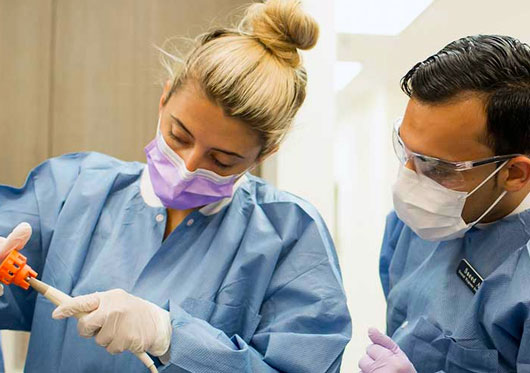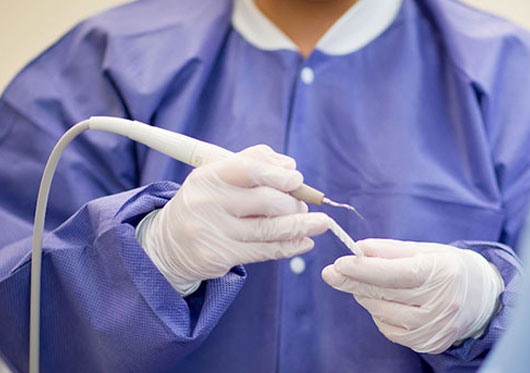Are you looking for a new job in health care? If so, becoming a dental hygienist might be just the career move for you.
According to the Bureau of Labor Statistics, dental hygienists are in high demand. With a projected 10-year growth rate of 9% (faster than average), and an average annual salary of $77,810, the job outlook is fantastic—making this a great time to enter the field. And as the population continues to age and technology advances, these already critical services will only become even more sought after.
If you’re considering a career as a dental hygienist, you may be wondering: What exactly does a dental hygienist do on a daily basis? Below are some of the most common roles, responsibilities, and tasks that you may encounter if you pursue this career. We also explain how you can become a dental hygienist, including potentially earning an associate’s or bachelor’s degree in dental hygiene.
The Key Responsibilities of a Dental Hygienist
Dental hygienists play an important role in patients’ health and well-being. By supporting the dentist and performing certain key duties like the ones outlined below, they form an integral piece of the dental hygiene puzzle for most patients.
1. Reviewing Dental and Health History
Before any dental work is done by either the hygienist or the dentist, the hygienist must conduct a medical history. This review is a critical tool that hygienists use to:
- Understand a patient’s previous dental work and medical conditions
- Understand any changes to overall health, prescription medications, or allergies
- Assess any oral health risks
- Prevent medical emergencies
The information gathered during this history will be used by the hygienist and dentist and inform the patient of a personalized dental treatment plan.
2. Screening Patients
In addition to collecting a dental health history, hygienists also actively screen patients for tooth decay and oral disease prior to the dentist performing any work.
This process may only take a few minutes to complete, but it’s an extremely important part of the process. By taking a quick inventory of head, neck, and mouth, it’s possible for a hygienist to identify problems before they spiral out of control.
3. Conducting Dental Cleanings
The part of a dental hygienist’s job with which you are probably most familiar is the dental cleaning.
Hygienists use a variety of tools and techniques to remove tartar, stains, and plaque from teeth, improving their patients’ dental health by preventing cavities and tooth loss while simultaneously helping them achieve the bright, beautiful smile that they want, while helping the patient to maintain their overall health.
4. Taking Dental X-rays
Dental x-rays play a pivotal role in preventative care. Hygienists take these x-rays so that they can spot problems in the early stages, and treat them before they have a chance to develop into more serious issues. Dental x-rays can also help the dentist detect cavities, gum disease, oral infections, and even some types of tumors.
How often x-rays are performed will vary from patient to patient based on their dental health, whether or not they exhibit signs of dental problems, their age, and their risk for oral disease. That being said, they’re a fairly common part of working as a dental hygienist.
5. Applying Preventive Care
After performing the cleaning, hygienists take a more proactive approach by educating the patient in preventive oral care. Precautionary treatments like fluoride and sealant application play an important role in promoting dental health between appointments.
Fluoride treatments are important because fluoride strengthens teeth and fortifies them against acid erosion. Fluoride not only helps prevent tooth decay, but it can also reverse early decay.
Sealants are helpful, particularly for children, in controlling decay in certain areas of the mouth. A dental sealant is an acrylic-like material that helps protect the chewing surfaces of the back teeth.
6. Teaching Patients Good Dental Hygiene
Patient education is a fundamental aspect of a dental hygienist’s job.
By teaching their patients how to best care for their mouth, they are effectively serving as public health ambassadors. Dental hygienists instruct patients of all ages on how to properly brush and floss their teeth, and also stress the importance of doing so. They may discuss the link between diet and oral health and make recommendations to help patients select toothbrushes and other oral care devices.
7. Helping Patients Improve and Maintain Good Dental Health
In line with the importance of patient education, dental hygienists help patients improve and maintain good dental health by promoting healthy habits and behaviors. Equipped with the knowledge of proper techniques, patients are more likely to maintain good dental health.
8. Documenting Care and Treatment as It’s Performed (and Communicating with the Dentist)
Hygienists serve as a bridge between the dentist and the patient. After cleaning a patient’s teeth and screening for oral disease, the hygienist reports their findings to the dentist. The hygienist preps patients for their visit with the dentist by educating the patient about their findings and outlining potential treatment options that the dentist may recommend or pursue. They will also review areas of concern that will be further addressed by the dentist.
Just as important as the actual care and treatment that a dental hygienist provides is the documentation of that care and treatment. Dental hygienists are key players in creating and maintaining dental records, as they keep track of everything that is discussed and performed during your visit.
How to Become a Dental Hygienist
If dental hygiene sounds like a career that you’d like to pursue, there are steps that you can take to help make your dream a reality.
In order to become a dental hygienist you will need to be licensed by the state in which you wish to work. Although every state requires licensure, the requirements vary from state to state. The minimum level of education required to become a dental hygienist is an associate’s degree from an accredited program, but earning a bachelor’s degree or more advanced degree can make it easier to advance your career and earn an even higher salary.
Regis College is one of the preeminent dental hygiene programs in New England, offering both associate and bachelor of science degrees. Our program has very high success rates, with 100% of students participating in outreach projects while in the program. Regis students have access to a campus dental center, which is home to an active dental hygiene practice. After their third year of study, students will be eligible to take board exams for licensure.


